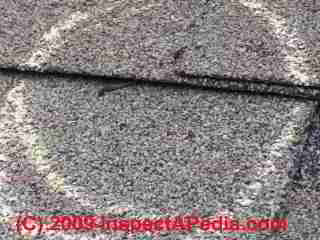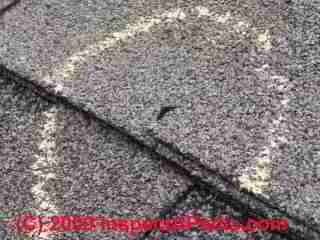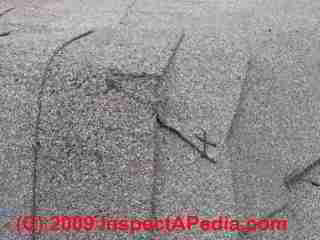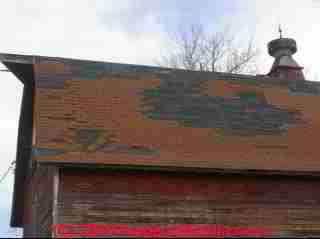 Staples vs Nails in Asphalt Shingles
Staples vs Nails in Asphalt Shingles
Asphalt Shingle Installation Methods
- POST a QUESTION or COMMENT about installing asphalt shingle roofing.
Asphalt shingle installation using a stapler versus a nailer:
Use of staples for asphalt shingle installation can work if you work carefully but in my experience you're asking for trouble.
Here we describe what can go wrong when using a roofing stapler on asphalt.
Roof shingles that are not adequately fastened to a sound roof deck are likely to blow off, as we illustrate in our photo above showing a semi-naked barn roof.
This article series discusses best roofing practices for the installation of asphalt roof shingles.
We describe asphalt shingle nailing type, size, spacing and locations. Asphalt roof shingle course offset requirements. Low slope and steep slope limits for asphalt shingles. Asphalt shingle roof flashing at eaves & skylights. Best practices for roofing material installation, flashing, ventilation, nailing, underlayment.
InspectAPedia tolerates no conflicts of interest. We have no relationship with advertisers, products, or services discussed at this website.
- Daniel Friedman, Publisher/Editor/Author - See WHO ARE WE?
Fastening (Nailing) Requirements for Asphalt Shingle Roofs
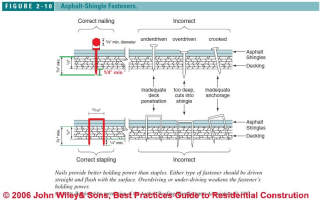 As we state in our companion article ASPHALT SHINGLE INSTALLATION - best practices,
As we state in our companion article ASPHALT SHINGLE INSTALLATION - best practices,
The preferred fastener is galvanized roofing nails with a minimum 12-gauge shank and head diameter of at least 3/8 inch.
Although staples are allowed in some jurisdictions, they do not provide the same holding power.
[Click to enlarge any image]
Both nails and staples should be long enough to penetrate the roof sheathing by 3/4 inch or penetrate 1/4 inch through the sheathing if it is less than 3/4 inch thick.
Fasteners should be driven straight and flush with the shingle surface (Figure 2-10 above, courtesy of Steven Bliss, Best Practices Guide to Residential Construction (Steve Bliss, J Wiley & Sons) ).
Overdriven nails or staples can cut into the shingle or crack it in cold weather.
Is it Acceptable to Use Staples to Install Asphalt Roof Shingles?
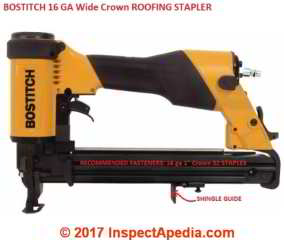 Roofing staple guns have been sold for nearly 40 years and in some models including the one I liked, are still available, such as the Stanley Bostitch 16-Gauge Wide Crown Roofing Staple Gun, shown here.
Roofing staple guns have been sold for nearly 40 years and in some models including the one I liked, are still available, such as the Stanley Bostitch 16-Gauge Wide Crown Roofing Staple Gun, shown here.
This stapler might also be used for securing house-wrap and other building materials.
Using staples to install roof shingles is not generally recommended in areas where the roof will be subject to wind damage, and as we excerpt from a GAF statement below, you will see a warning about using staples that does not narrow the stapled-shingle caveat to just high-wind areas.
Watch out: some writers, including for roofing company websites state that " ... both staples and nails are approved by some roofing manufacturers...", suggesting that using a stapler gives performance and wind damage resistance equal to shingles secured with roofing nails.
"some roofing manufacturers" is a bit vague and may not be accurate since it's hard to pin down a maybe.
While staples remain an acceptable shingle fastener on manufactured housing, staples are not an approved shingle fastener in most current residential building codes. - (Donan retrieved 2017)
Excepting comments such as by Donan, our review (September 2017) did not find a building code nor a roofing shingle manufacturer explicitly recommending the use of staples to secure asphalt roofing on residential structures. FEMA specifically recommends the use of roofing nails, not staples in high wind areas.
Let's look at the IRC model building code on roof shingle fasteners:
R905.2.5 Fasteners.
Fasteners for asphalt shingles shall be galvanized steel, stainless steel, aluminum or copper roofing nails, minimum 12 gage [0.105 inch (3 mm)] shank with a minimum 3/8-inch (10 mm) diameter head, ASTM F 1667, of a length to penetrate through the roofing materials and a minimum of 3/4 inch (19 mm) into the roof sheathing.
Where the roof sheathing is less than 3/4 inch (19 mm) thick, the fasteners shall penetrate through the sheathing. Fasteners shall comply with ASTM F 1667. - IRC 2006 (New Jersey coph), Section R905.2.5 in IRC CHAPTER 9 ROOF ASSEMBLIES [PDF] (2003)
Disclosure: my first roofing "nailer" was in fact a staple gun, a yellow Stanley Bostitch staple gun. I loved it. Fast, light, easy, durable, reliable, rarely jammed. Senco also produced popular roof shingle staplers that are still in use.
But it didn't take more than the first five minutes with my new roof shingle stapler, to discover that if I didn't take care my staples would give me (and the roof and my client) trouble.
Here are some of the typical roof shingle staple snafus:
Seven Ways to Foul-up a Roof Shingle Stapling Job
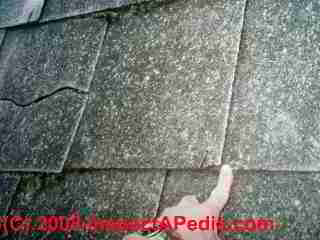 If experience is the best teacher, after a strong wind storm roofers who used a stapler might want to go check on their stapled roof shingle jobs.
If experience is the best teacher, after a strong wind storm roofers who used a stapler might want to go check on their stapled roof shingle jobs.
They might find that their crew made some of the same mistaked I did. Back in the day.
Really? Let me say at the outset to all you staplers that all of these mistakes can be made with a roof nailer as well as a roof stapler.
However anybody who has worked with a roofing stapler and who's not president littlehands has a duty to be truthful: they'll agree that truth be told, it's easier to cut through an asphalt shingle with a staple than with a roofing nail.
- Wrong Fastener for Roof Material: my finger is just to the right of a staple used to try to salvage this cement-asbestos roof by re-fastening loose tiles. Using an impact nailer, air, gas, or electric, on slate or fiber cement or in this case asbestos-cement roofs invites damaged slates or tiles.
OK so you'd never do something this dumb, right? Moving right along: - Cocked asphalt shingle staples: Roofers who get tired of scrambling over a hot steep roof surface develop long arms. Or wish they could.
It is just too tempting to reach waaaay over to the right or left to staple just one more shingle before taking another step
When you reach waaay over with your stapler the nose of the tool will be cocked at an angle with respect to the plane of the roof surface. Either that or after an hour of stapling your wrist will be killing you.
A roofing staple gun must be fired with the gun tip parallel to and flush on the shingle surface, otherwise one end of the shingle is left sticking up, ready to puncture the overlying tab of the next course either from being heated in the sun or from your heavy-footed laborer who steps on it right before he slams down another bundle of shingles.
I carried a hammer to smash down cocked roof shingle staple ends. That didn't work out so well. A cocked staple has probably already cut into the shingle at its low end.
Smacking down too hard on the high end of a shingle staple pushes it right into the shingle, cutting it and leaving the shingle with no fastener.
So the roofer has to slow down (lose money) to stop, notice a a cocked staple, take out the hammer, smack down the staple, then working with care, shoot another staple close by.
Above: a cocked roof shingle staple pokes its pointy little head up at its lower end and cut right through shingles at its upper end.
This staple is also mis-placed, too low on the shingle. It should have been covered by the shingles of the successive course above.
- Over-driven asphalt shingle staples: Even when I held the stapler properly, tip not cocked at an angle, either my enthusiasm or my visceral fat spare tire would sometimes cause me to press down too hard on my stapler, driving the staple right through the shingle.
Roofers who work fast and set their nailer to a higher pressure than specified by the staple gun's manufacturer will also over-drive staples.
A gas operated stapler or nail gun has less of this trouble but you can still push down with too much force when stapling or nailing.
Stapling shingles on a hot day, through sun-softened shingles also encouratges over-driving staples and cut shingles, as does working too fast or setting the stapler's air pressure too high.
Above: another shingle staple, over driven from above cut right through two shingle courses. Mis-placed (too low) and damaged the asphalt layers of the two shingle courses.
Don't be surprised to find the same mistake repeated on multiple areas of a roof or on multiple roofs at different buildings if the same crew are working consistently.
- Under-driven asphalt shingle staples: ok so after some practice I learned the proper air pressure adjustment, stapler nose adjustment, and downwards pressure each time I fired a staple into my shingle and roof deck.
I took care that the wire of the shingle was all the way down touching, but not cutting into the asphalt shingle.
Then I'd speed up a bit, blam-1 blam-2 blam-3 blam-4, four quick staples. Stop! Why is blam-3 sticking up?
Because it hit either a nail in the plywood roof deck or because it hit a knot in the plywood. Darn. - Excessive roof shinngle staples in one spot: I never did this. Well rarely. But my helper was of the school that more is better.
If she wasn't sure a staple was driven perfectly she'd shoot five more quickly into the same spot. Blam, blam, blam, blam, BLAM! cutting the heck out of the shingle and inviting wind blow-off. Sigh. - Wrong staple location: stapling too low exposes the staple and can invite roof leaks. Stapling too high invites wind damage and blow-off.
Details about fastener location in asphalt shingles are
at ASPHALT SHINGLE INSTALLATION - Exposed staples: a madwoman with the staple gun, my helper shot staples like popcorn all over the place on some roofs before we had a little talk about continued employment.
Below: (not our roofing job) you can see exposed staples just below the apex of an asphalt shingle roof hip ridge cap.
Watch out: the following is an excerpt from a GAF Technical Advisory Bulletin warning about the use of staples to secure asphalt shingles:
Staples are not recommended by GAF and most industry organizations
…Staples made of at least 16-gauge galvanized steel with a minimum crown of 15/16” (24 mm) have been and continue to be used by some applicators to install shingles.
If staples are used to install GAF shingles, our limited shingle warranty will remain in effect.
However any problems resulting from the use of staples, including wind blow-off, are not covered by the warranty.
... Most local building codes do not permit the use of staples…
Here is another position statement on use of roofing shingle staples from IKO
Q: Which type of fastener should be used to install asphalt shingles – nails or staples?
A: IKO agrees with and supports the ARMA position that nails are the preferred method of fastening asphalt roof shingles due to their superior holding strength.
Research on Use of Staples vs Nails in Asphalt Shingle Roofs
 The roofing nail sketch of common roof shingle nailing errors shown here is a detail from FEMA's , Asphalt Shingle Roofing for High Wind Regions [2].
The roofing nail sketch of common roof shingle nailing errors shown here is a detail from FEMA's , Asphalt Shingle Roofing for High Wind Regions [2].
This sketch points out that mis-driven nails can also lead to shingle WIND DAMAGE - live link given below.
Roofing product manufacturers are careful to specify where shingle nails should be placed in each shingle and the number of nails required. (Typically four, six in high wind zones, plus other measures to avoid wind damage.
In addition to the number of nails, how nails are driven is critial to a shingle's ability to stay on the roof.
The following example comments on roofing nails are from the GAF Materials Corporation Grand Timberline™ Premium Architectural Shingle Application Instructions [at Reviewers]
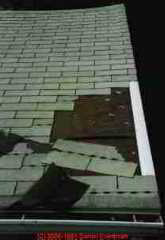 FASTENERS: Use of nails is recommended.
FASTENERS: Use of nails is recommended.
Use only zinc coated steel or aluminum, 10-12
gauge, barbed, deformed or smooth shank roofing nails with heads 3/8" (10mm) to 7/16" (12mm)
in diameter. Fasteners should be long enough to penetrate at least 3/4" (19mm) into wood decks or just through the plywood decks.
Fasteners must be driven flush with the surface of the shingle. Over driving will damage the shingle. Raised fasteners will interfere with the sealing of the shingles.
Even a nailed-on roof can blow off in high wind. These shingles were lifted along the drip edge and ripped right off of this garage roof less than two years after I had installed it. More about this particular wind damaged roof is
References for Roof Shingle Staples vs Nails
- Asphalt Roofing Manufacturers Association (ARMA), Public Information Department 750 National Press Building 529 14th Street, NW Washington, DC 20045 Tel: (202) 591-2450
- ASPHALT SHINGLE ROOFING for HIGH-WIND REGIONS [PDF] (2004) FEMA, Hurricane Recovery Advisory,
- ASPHALT SHINGLE ROOFING FOR HIGH WIND REGIONS, HOME BUILDERS' GUIDE TO COASTAL CONSTRUCTION [PDF], FEMA 499, August 2005, Technical Fact Sheet No. 20.
- Donan, J. Lyle, P.E. CFEI, SELF SEALING ASPHALT SHINGLES FAILURE ANALYSIS [PDF] Donan Engineering Co., Inc.
11321 Plantside Drive, Louisville, Kentucky 40299 800-814-7503 www.donan.com (un-dated) retrieved 2017/09/27, original source http://www.completecontracting.com/wp-content/uploads/ 2015/12/selfSealingAsphalt-TechBulliten1-sealStrip-1.pdf
Excerpt: While staples remain an acceptable shingle fastener on manufactured housing, staples are not an approved shingle fastener in most current residential building codes. - Dixon, Craig Robert, THE WIND RESISTANCE OF ASPHALT ROOFING SHINGLES, [PDF] (2013 Dissertation thesis), University of Florida, retrieved 2017/09/27, original source http://ufdc.ufl.edu/UFE0046235/00001,
Excerpt:
Florida Building Code (2010), Building Commission 2010) requires that fasteners should consist of:
Galvanized steel, aluminum or copper roofing nails, minimum 12 gage [0.105 in (3 mm)] shank with minimum 3/8 in (10 mm) diameter head, ASTM F 1667, of a length to penetrate through the roofing materials and a minimum of ¾ in (19 mm) into the roof sheathing.
Where the roof sheathing is less than ¾ in (19 mm) thick, the fasteners shall penetrate through the sheathing.
Florida Building Code also requires a minimum of four fasteners per strip, and, where the structure is within the High-Velocity Hurricane Zone (Broward and Miami-Dade, FL counties), a minimum of six nails are required (Florida Building Commission 2010). Fasteners are either placed by hand or pneumatic air pressure guns. - GAF STAPLES VS. NAILS FOR SHINGLE APPLICATION [PDF], GAF Technical Advisory Bulletin No. TAB-R-2011-132 (2011) retrieved 2017/09/27, original source: https://www.gaf.com/Warranties_ Technical_Documents/Steep_Slope_ Technical_Advisory_ Bulletins/English_Bulletins/ Staples_vs_Nails_for_Shingle _Applications_Steep_Slope_ Technical_Point_TAB_R_2011_132.pdf
- IKO, "Which type of fastener should be used to install asphalt shingles – nails or staples?", FAQ, retrieved 2017/09/27, original source: https://www.iko.com/na/residential /homeowner/faq /#Which-type-of-fastener-should
...
Continue reading at ASPHALT SHINGLE INSTALLATION - best practices, or select a topic from the closely-related articles below, or see the complete ARTICLE INDEX.
Or see these
Recommended Articles
- ASBESTOS CEMENT ROOF REPAIR - more about the stapled asbestos cement roof shown in this article
- ASPHALT SHINGLE LIFE / WEAR FACTORS
- ASPHALT SHINGLES on LOW SLOPE ROOFS
- SHINGLE EXPOSURE AMOUNT
- ASPHALT ROOF SHINGLES - home
- MECHANICAL DAMAGE of SHINGLES - describes damage caused by improper staple installation in stapled asphalt shingle roofs
- WARRANTIES for ROOF SHINGLES
- WIND DAMAGE to ROOFS - describes asphalt shingle damage and shingle loss where improperly-stapled shingles were installed on roofs
- WOOD ROOF INSTALLATION SPECS - describes use of staples vs nails for wood shingle or shake installation.
Excerpt:
In dry climates, good quality electrogalvanized staples, conforming to ASTM A641, are satisfactory according to the Cedar Shake and Shingle Bureau, but from our field experience we prefer nails.
Suggested citation for this web page
ASPHALT SHINGLE STAPLE vs NAIL at InspectApedia.com - online encyclopedia of building & environmental inspection, testing, diagnosis, repair, & problem prevention advice.
Or see this
INDEX to RELATED ARTICLES: ARTICLE INDEX to BUILDING ROOFING
Or use the SEARCH BOX found below to Ask a Question or Search InspectApedia
Ask a Question or Search InspectApedia
Questions & answers or comments about the best practices to follow when installing asphalt shingle roofing..
Try the search box just below, or if you prefer, post a question or comment in the Comments box below and we will respond promptly.
Search the InspectApedia website
Note: appearance of your Comment below may be delayed: if your comment contains an image, photograph, web link, or text that looks to the software as if it might be a web link, your posting will appear after it has been approved by a moderator. Apologies for the delay.
Only one image can be added per comment but you can post as many comments, and therefore images, as you like.
You will not receive a notification when a response to your question has been posted.
Please bookmark this page to make it easy for you to check back for our response.
IF above you see "Comment Form is loading comments..." then COMMENT BOX - countable.ca / bawkbox.com IS NOT WORKING.
In any case you are welcome to send an email directly to us at InspectApedia.com at editor@inspectApedia.com
We'll reply to you directly. Please help us help you by noting, in your email, the URL of the InspectApedia page where you wanted to comment.
Citations & References
In addition to any citations in the article above, a full list is available on request.
- "GAF-Elk Timberline ® Prestique ® Grande ® 40 High Definition Roofing Shingles Product Information" (2008) GAF-Elk Corporation 5/08 13 61 Alps Road, Wayne, NJ 07470 www.gaf.com, retrieved 9/8/2014, original source: http://www.gaf.com/Other_Documents/ Legacy_Products_Discontinued/Timberline_Prestique_Grand%C3%A9 /Timberline_Prestique_Grande_40_Info_Spec_Sheet.pdf [Note that this is a discontinued product]
- GAF Materials Corporation, Grand Timberline Premium Architectural Shingle Application Instructions.
http://www.gaf.com/Content/Documents/20573.pdf discusses the requirements for successful asphalt shingle installation including the condition of the roof deck, the use of roofing felt underlayment, the selection of roofing nails by type and length and penetration of the roof decking, and the role of glue strips on the back side of asphalt roof shingles. - Roofing The Right Way, Steven Bolt, McGraw-Hill Professional; 3rd edition (November 1, 1996), ISBN-13: 978-0070066502, p. 350 for one of many citations on this point.
- "Hurricane Damage to Residential Structures: Risk and Mitigation", Jon K. Ayscue,
The Johns Hopkins University, Baltimore, Maryland, published by the Natural Hazards Research and Applications Information Center, Institute of Behavioral Science, University of Colorado, November 1996. Abstract:
"Property damage and loss from hurricanes have increased with population growth in coastal areas, and climatic factors point to more frequent and intense hurricanes in the future. This paper describes potential hurricane hazards from wind and water. Damage to residential structures from three recent intense hurricanes - Hugo, Andrew, and Iniki - shows that wind is responsible for greater property loss than water. The current state-of-the-art building technology is sufficient to reduce damage from hurricanes when properly applied, and this paper discusses those building techniques that can mitigate hurricane damage and recommends measures for mitigating future hurricane damage to homes." - online at www.colorado.edu/hazards/publications/wp/wp94/wp94.html - "Evaluating OSB for Coastal Roofs," Paul Fisette, Coastal Contractor, Winter 2005, online at coastalcontractor.net/pdf/2005/0501/0501eval.pdf . Fisette cites: "Jose Mitrani, a civil engineer and professor at Florida. International University in Miami, was ... Florida’s official damage assessment team. ... After Hurricane Andrew, Florida code advisers ruled OSB sheathing inferior to plywood."
- ARMA - Asphalt Roofing Manufacturer's Association - Asphalt Roofing Manufacturer's Association - https://www.asphaltroofing.org/
750 National Press Building, 529 14th Street, NW, Washington, DC 20045, Tel: 202 / 207-0917 - ASTM International, 100 Barr Harbor Drive, PO Box C700, West Conshohocken, PA, 19428-2959 USA The ASTM standards listed below can be purchased in fulltext directly from http://www.astm.org/
- NRCA - National Roofing Contractors Association - Website: www.nrca.net 10255 W. Higgins Road, Suite 600, Rosemont, IL 60018-5607, Tel: (847) 299-9070 Fax: (847) 299-1183
- "Applying Shingles on Extreme Slopes", Dave Flickinger, RRO, Professional Roofing, July 1999. [PDF copy] - National Roofing Contractors Association - http://www.nrca.net/, 10255 W. Higgins Road, Suite 600, Rosemont, IL 60018-5607, Tel: (847) 299-9070 Fax: (847) 299-1183, Office hours: 8 a.m. to 5 p.m. CST
- UL - Underwriters Laboratories - https://www.ul.com/
2600 N.W. Lake Rd.
Camas, WA 98607-8542
Tel: 1.877.854.3577 / Fax: 1.360.817.6278 E-mail: cec.us@us.ul.com - Our recommended books about building & mechanical systems design, inspection, problem diagnosis, and repair, and about indoor environment and IAQ testing, diagnosis, and cleanup are at the InspectAPedia Bookstore. Also see our Book Reviews - InspectAPedia.
- Asphalt Roofing Residential Manual from ARMA the Asphalt Roofing Manufacturers Association Website https://www.asphaltroofing.org/product/residential-asphalt-roofing-manual/ , book for sale at Amazon
- Building Pathology, Deterioration, Diagnostics, and Intervention, Samuel Y. Harris, P.E., AIA, Esq., ISBN 0-471-33172-4, John Wiley & Sons, 2001 [General building science-DF] ISBN-10: 0471331724 ISBN-13: 978-0471331728
- Low Slope Roofing, Manual of, 4th Ed., C.W. Griffin, Richard Fricklas,
McGraw-Hill Professional; 4 edition, 2006, ISBN-10: 007145828X, ISBN-13: 978-0071458283
- Roof failure causes in depth (and specific methods for avoiding them)
- Roof design fundamentals and flourishes, based on voluminous industry research and experience
- New technologies and materials -- using them safely and correctly
- Comprehensive coverage of all major roofing systems pecifications, inspection, and maintenance tools for roofing work
- Problems in Roofing Design, B. Harrison McCampbell, Butterworth Heineman, 1991 ISBN 0-7506-9162-X (available used)
- Roofing The Right Way, Steven Bolt, McGraw-Hill Professional; 3rd Ed (1996), ISBN-10: 0070066507, ISBN-13: 978-0070066502
- Wood Shingle Roofs, Care and Maintenance of wood shingle and shake roofs, (EC), Stanley S. Niemiec (out of print)
- In addition to citations & references found in this article, see the research citations given at the end of the related articles found at our suggested
CONTINUE READING or RECOMMENDED ARTICLES.
- Carson, Dunlop & Associates Ltd., 120 Carlton Street Suite 407, Toronto ON M5A 4K2. Tel: (416) 964-9415 1-800-268-7070 Email: info@carsondunlop.com. Alan Carson is a past president of ASHI, the American Society of Home Inspectors.
Thanks to Alan Carson and Bob Dunlop, for permission for InspectAPedia to use text excerpts from The HOME REFERENCE BOOK - the Encyclopedia of Homes and to use illustrations from The ILLUSTRATED HOME .
Carson Dunlop Associates provides extensive home inspection education and report writing material. In gratitude we provide links to tsome Carson Dunlop Associates products and services.


